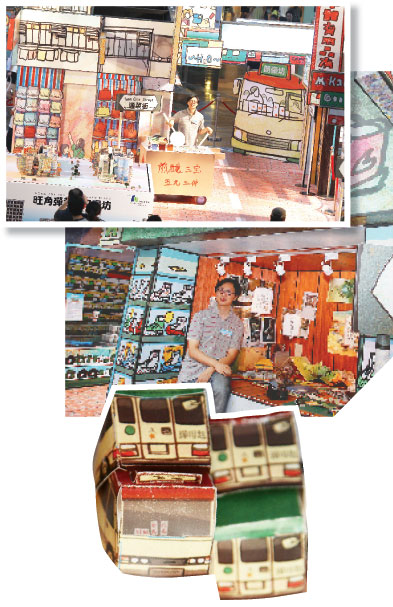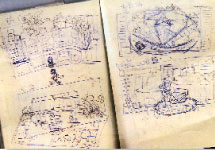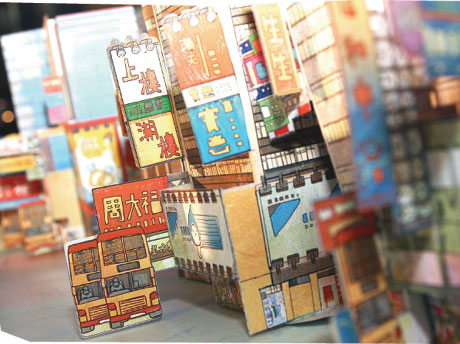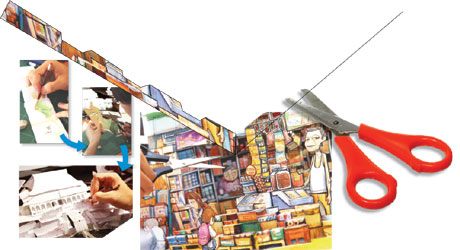Poppin' up at you
Updated: 2010-08-25 08:10
By Guo Jiaxue and Edmond Tang(HK Edition)
|
|||||||||
|
Kit Lau Sze-ki presents his latest pop-up book, Mongkok Pop Up. Edmond Tang / China Daily |

Captivated by a children's pop-up book about dinosaurs, Kit Lau Sze-ki set out to create his own pop-up books, featuring real life scenes of Hong Kong and the mainland. Guo Jiaxue and Edmond Tang report.
Pop-up books? Oh yes, we all remember them from our childhood. We found them exciting, interactive, and everything else we didn't find in classic literature. But now, when the topic of three dimensional images comes up, people usually are talking about the latest movies where audiences wear specially made glasses; devour pop corn, scream, laugh, and enjoy the fast-changing visual technology.
Kit Lau Sze-ki didn't buy into the 3D movie craze. The new guy in the city's publishing world sticks to pop-up books, which he considers one of the oldest ways to express the dynamic 3D image.
"They are more than just books. They are made with a great deal of complex handiwork, which is very rare. Every pop-up book is actually a piece of paper sculpture," Lau said. He argues that the pop-up books have features that digital technology could never present. "You can touch it, you can feel the texture, the weight!"
His latest works are two huge pop-up books about Mong Kok. When opened, the books can extend up to two-meter-long, two-meter-wide, and one-meter-high. Crowds ply the bustling streets, revealing a picture of typical Mong Kok life in full color before the reader's eyes. A man who sells fishballs stands behind his cart greeting customers. A small boy, his school books stowed in a bag on his shoulder, hangs out at a candy store eyeing the treats on the shelves. Most of the area's iconic architecture can be found within the pages of the book: Sneaker street and Women's street are two examples.
"The character of Mong Kok is density," said Lau. Countless advertising boards set out in bold colors and sizes hang above the busy streets gazing down on the traffic below. Modern mansions in cold color tones and old buildings with decades of history stand side by side. "Mong Kok can represent Hong Kong very well."
Two years ago, Lau came across a dinosaur book created by the world-famous 3D paper engineer Robert Sabuda. The magic Lau discovered from the time he first opened the pages until he closed them proved an irresistible attraction. He loved models and transformer toys when he was a boy. After looking through the dinosaur book, Lau was determined to learn the technique and create a pop-up book of his own.
It wasn't easy at first, because pop-up books are not as popular in Hong Kong as they are in the West. Lau soon found there was nowhere he could learn the skills in Hong Kong. "I studied other author's works to try to figure out some basic skills," he said.

Soon he became swept up in the challenge. "The idea is very important, as I have to work out the idea with my limited skills ... My way of doing this is pretty much throwing spaghetti at the wall."
To finish his first book Hong Kong Pop Up, Lau took a full year. His second book China Pop Up took nine months. His third book, Mongkok Pop Up, took him a little more than a month.
It took time but he made it. His works received incredibly good market response.
Lau prefers to tell local stories of the city, not only Hong Kong's architecture, which he has covered already. He's also interested in the changes in local transportation. He's noticed that more and more local artists, even those who produce comic books are making efforts to promote the local culture of Hong Kong. "Which is good. And I am glad I can be one of them," he said.
"It's interesting stuff, something funny, something that can make people happy."
|
Kit Lau Sze-ki demonstrates how to make a pop-up book. Edmond Tang / China Daily |
(HK Edition 08/25/2010 page6)

